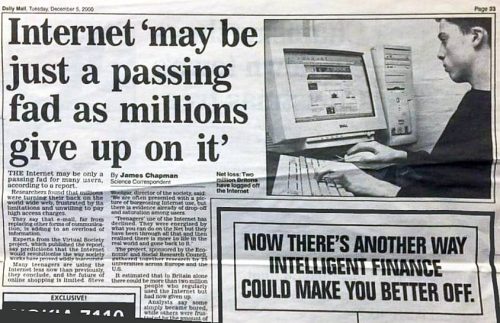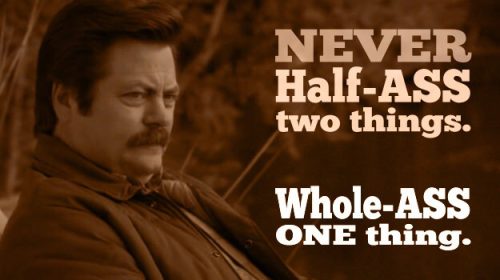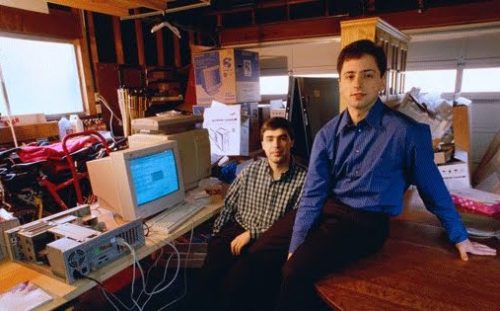“If [insert x] fails, NFTs will fail”. Yes, the gold rush is over.
25 years ago, the internet bubble burst. One day you could raise millions with a powerpoint, the next you had to show an MVP & a business plan with profitability milestones to raise half the amount.
 History doesn’t repeat itself, but it often rhymes. The times where any project with an undoxxed founder, a newly created discord yet with a following of thousands on twitter could mint out in minutes are long gone. The times where you could hype up a “new chapter” or a vague promise is over. The market – we, the investors / collectors / tradooors – has matured and is no longer willing to invest blindly in non-sense… to the extent that lots have lost faith in “NFTs”, and simply left the market. “NFTs are a scam”.
History doesn’t repeat itself, but it often rhymes. The times where any project with an undoxxed founder, a newly created discord yet with a following of thousands on twitter could mint out in minutes are long gone. The times where you could hype up a “new chapter” or a vague promise is over. The market – we, the investors / collectors / tradooors – has matured and is no longer willing to invest blindly in non-sense… to the extent that lots have lost faith in “NFTs”, and simply left the market. “NFTs are a scam”.
The same as 25 years ago when lots of VCs changed gears and avoided the “internet scam”.
But… are NFTs actually a scam?
- 90% of startups fail. Are start-ups a scam?
- 90% of the 33 million books available on Amazon are trash. Are books a scam?
- 90% of the 80 million songs available on Spotify are garbage. Is music a scam?
- 90% of 95 million photos published on Instagram each day are artistically horrible. Is photography a scam?
Today, storytelling is ahead of reality. The excitement of early adopters is undeniable, we all see the potential & future value of NFTs, but a lot needs to be done first before we see the holy grail of mass adoption.
We are in 1998. Google was just launched. Facebook will be launched in 2004. Apple will launch the first iPhone in 2007.
If we compare the adoption curves of crypto & the internet, this is where we are today in 2023. “Mass adoption” will happen, but it will take time. Probably less time than the internet revolution, the pace of innovation has drastically sped up, but still.
NFTs are a revolutionary piece of technology which created something unique yet overlooked: Digital Scarcity, with a trustable & immutable ledger in the middle, decentralized blockchains. They offer undeniable benefits in a Digital World: ownership & provenance, immutability, security & efficiency, transparency & traceability, permissionless.
And the first core competitive advantage of Digital Scarcity is no other than the aligned incentive between the creator & the holder. The resource is finite and both parties – the creator & the holder – share aligned interests.
So, why are NFTs taking a big dip lately?
My conviction is that we have a major issue of trust & market environment.
 First, trust in the leaders & founders.
First, trust in the leaders & founders.
All the projects shutting down lately have clearly shed the light on how certain founders are inexperienced, clueless, or just malicious. Startups or projects failing as they didn’t find the right Product Market Fit is one thing, but those halting operations because they “run out of funds” completely mismanaging them (the majority) is alarming. And I can’t encourage you enough to read this article by Denomics “Unveiling the web3 realities” which essentially lays stress on being able to actually assess a founders background with transparency before we put any money on the table for their ventures.
Second, we have IMO a systemic market environmental issue: NFTs liquidity
Almost all major recent innovations are centered on one goal: making NFTs more liquid.
The latest launch of the Flooring Protocol on ETH is a perfect case in point.
Not to mention all the innovations from the last 12 months that have completely distorted the ecosystem into a sellers market, creating a huge imbalance between buyers & sellers:
- AMMs made it easier than ever to sell your (no longer) favorite NFTs. Short term, they drive the value higher, as AMM pools first need to buy to start operating. And then, anyone can suddenly sell into bids. Not to mention when an AMM stops operating.
- Royalties on the buyers’ side increased the friction for buying NFTs, even more as marketplaces are showing different prices – including / excluding creator &/or marketplace fees – adding more complexity. If we want collectors to enjoy buying, we will need to reduce friction, not require a PHD to understand what we are doing.
- Marketplace point farming goes in the same vein. If one is rewarded for bidding instead of buying from the floor, and is aiming to floor his items to bid more, just to farm points, well, another layer of friction is added for collectors.
- And please, don’t mention the most recent “lucky buys” by your favorite Solana marketplace. It’s just pure gambling. And remember, the house (did I say Casino?) always wins.
Once a collectors market, now a traders playground.
Once a mid to long term investment, now a short term trade where marginal gains are the grails.
Time has been distorted, and mindsets have shifted. We are investing in wannabe startups, yet we want our investment to double nek minnit. It’s simply not viable, for various reasons:
 From a collectors’ perspective, if we want “mass adoption”, do we really think that the masses will come and hang out on Discord, check announcements daily, and monitor the daily volatility of their investments? Let’s be serious for a second.
From a collectors’ perspective, if we want “mass adoption”, do we really think that the masses will come and hang out on Discord, check announcements daily, and monitor the daily volatility of their investments? Let’s be serious for a second.
The Metaverse is a wonderful dream, but we won’t live in a Ready Player One world all day long anytime soon. At least not the majority of potential investors.
From a project’s standpoint: my conviction is that, in order to succeed, startups need razor focus. They have limited funds, runway and human resources. They shouldn’t think about the price of their stakes (aka NFTs) for most of the time. They focus on their core value proposition, not daily valuation.
By creating a sellers market, NFT project founders were forced to “build in public” even more: split their focus between building & reassuring the community. Yet, only a handful of founders can handle that. There is a reason why startups aren’t traded on the open market, as opposed to sustainable corporations.
There is or should be a moment for building (80%+ of time) and a moment for communicating. Or as LeeWay would argue…

So, what shall we do?
Here’s my proposal: cut down on NFTs trading daily.
What if we’d introduce vesting periods based on milestones & achievements. NFTs would be open for trading only during a predetermined period of time. Say differently, have pre-seed, seed, series A… rounds equivalents, but for NFTs backed projects.
And once the project is mature & sustainable enough, it could be introduced to the NFT open market, or be tradeable daily, based on certain criteria (recurring income, critical mass, development stage, etc.)

As an investor, if you believe in the project, its founder & its vision, you invest betting that they will meet the right product market fit, and meanwhile you sit on your hands.
NFTs trading periods would be scheduled beforehand, based on certain project milestones. Each milestone is tied with a key moment in the product delivery roadmap so that, once trading opens, buyers & sellers can agree on prices based on achievements & future plans, not just pure speculation, hype & FOMO. Once the trading period is over, Founders go back to the basement.
My rationale is the following: do you want your favorite founder to spend 50% of his time managing your fears & concerns on Twitter & Discord all day long to avoid the FUD, or do you want him to focus on cooking, and leveraging the community whenever he feels right to?
We’d meet the best of both worlds: investing in a startup supporting a project we believe in, having the opportunity to actively take part in its development, as well as bonding with like minded individuals who share the same interests. We’d connect and join discord chats & VCs more seldomly, only when summoned by the project, or community members, and then go back to our lives.
I hear you, traders, who want the opportunity to get rid of your assets whenever you feel like. But I’m afraid investing & trading for such young projects in the making can’t coexist in the long run. And we have to make a choice. The traders route has proven to be a ticking bomb for NFTs. Why not try the other one?



 History doesn’t repeat itself, but it often rhymes. The times where any project with an undoxxed founder, a newly created discord yet with a following of thousands on twitter could mint out in minutes are long gone. The times where you could hype up a “new chapter” or a vague promise is over. The market – we, the investors / collectors / tradooors – has matured and is no longer willing to invest blindly in non-sense… to the extent that lots have lost faith in “NFTs”, and simply left the market. “
History doesn’t repeat itself, but it often rhymes. The times where any project with an undoxxed founder, a newly created discord yet with a following of thousands on twitter could mint out in minutes are long gone. The times where you could hype up a “new chapter” or a vague promise is over. The market – we, the investors / collectors / tradooors – has matured and is no longer willing to invest blindly in non-sense… to the extent that lots have lost faith in “NFTs”, and simply left the market. “ First,
First,  From a collectors’ perspective, if we want “mass adoption”, do we really think that the masses will come and hang out on Discord, check announcements daily, and monitor the daily volatility of their investments? Let’s be serious for a second.
From a collectors’ perspective, if we want “mass adoption”, do we really think that the masses will come and hang out on Discord, check announcements daily, and monitor the daily volatility of their investments? Let’s be serious for a second. 
